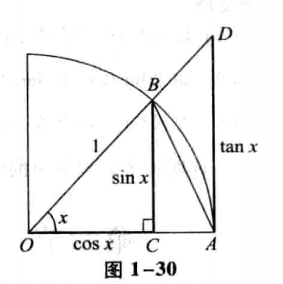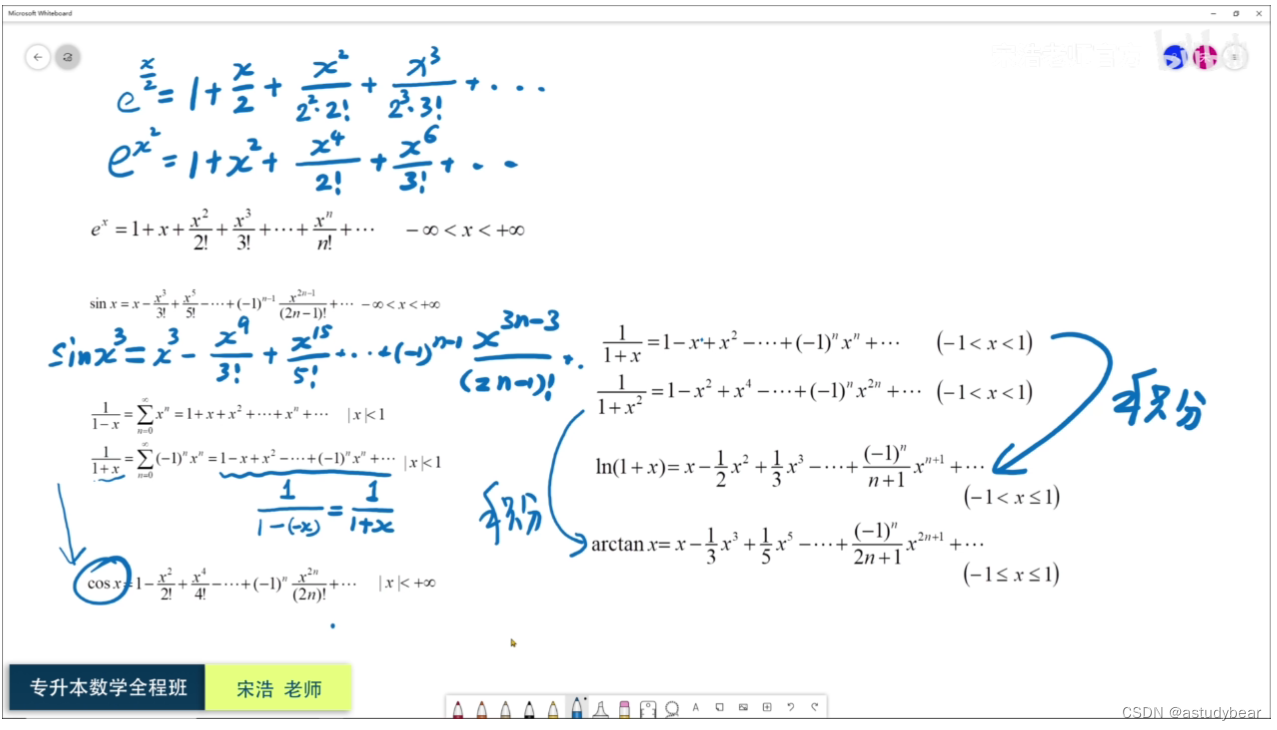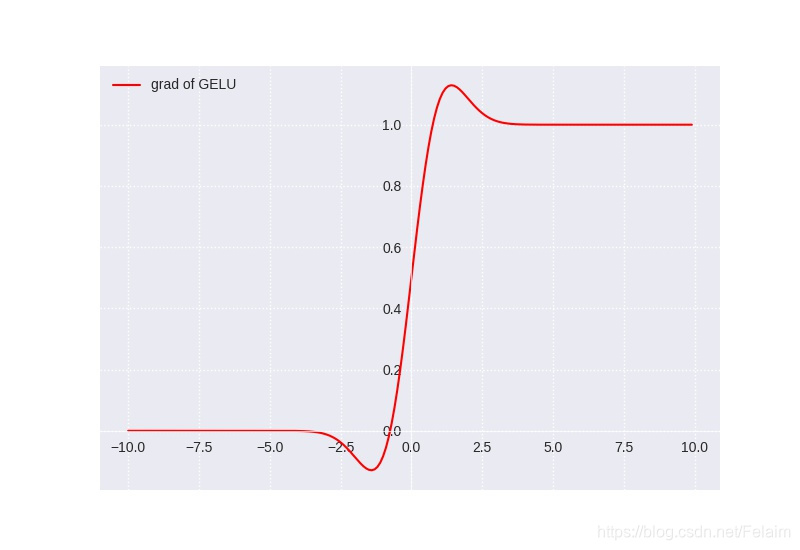高等数学(第七版)同济大学 习题10-2(中5题)
函数作图软件:Mathematica
11. 画 出 积 分 区 域 , 把 积 分 ∬ D f ( x , y ) d x d y 表 示 为 极 坐 标 形 式 的 二 次 积 分 , 其 中 积 分 区 域 D 是 : \begin{aligned}&11. \ 画出积分区域,把积分\iint_{D}f(x, \ y)dxdy表示为极坐标形式的二次积分,其中积分区域D是:&\end{aligned} 11. 画出积分区域,把积分∬Df(x, y)dxdy表示为极坐标形式的二次积分,其中积分区域D是:
( 1 ) { ( x , y ) ∣ x 2 + y 2 ≤ a 2 } ( a > 0 ) ; ( 2 ) { ( x , y ) ∣ x 2 + y 2 ≤ 2 x } ; ( 3 ) { ( x , y ) ∣ a 2 ≤ x 2 + y 2 ≤ b 2 } , 其 中 0 < a < b ; ( 4 ) { ( x , y ) ∣ 0 ≤ y ≤ 1 − x , 0 ≤ x ≤ 1 } . \begin{aligned} &\ \ (1)\ \ \{(x, \ y)\ |\ x^2+y^2 \le a^2\}\ (a \gt 0);\\\\ &\ \ (2)\ \ \{(x,\ y)\ |\ x^2+y^2 \le 2x\};\\\\ &\ \ (3)\ \ \{(x, \ y)\ |\ a^2 \le x^2+y^2 \le b^2\},其中0 \lt a \lt b;\\\\ &\ \ (4)\ \ \{(x, \ y)\ |\ 0 \le y \le 1-x,0 \le x \le 1\}. & \end{aligned} (1) {(x, y) ∣ x2+y2≤a2} (a>0); (2) {(x, y) ∣ x2+y2≤2x}; (3) {(x, y) ∣ a2≤x2+y2≤b2},其中0<a<b; (4) {(x, y) ∣ 0≤y≤1−x,0≤x≤1}.
解:
( 1 ) 积 分 区 域 D = { ( ρ , θ ) ∣ 0 ≤ ρ ≤ a , 0 ≤ θ ≤ 2 π } , 所 以 ∬ D f ( x , y ) d x d y = ∬ D f ( ρ c o s θ , ρ s i n θ ) ρ d ρ d θ = ∫ 0 2 π d θ ∫ 0 a f ( ρ c o s θ , ρ s i n θ ) ρ d ρ . \begin{aligned} &\ \ (1)\ 积分区域D=\{(\rho, \ \theta)\ |\ 0 \le \rho \le a,0 \le \theta \le 2\pi\},所以\\\\ &\ \ \ \ \ \ \ \ \iint_{D}f(x, \ y)dxdy=\iint_{D}f(\rho cos\ \theta, \ \rho sin\ \theta)\rho d\rho d\theta=\int_{0}^{2\pi}d\theta\int_{0}^{a}f(\rho cos\ \theta, \ \rho sin\ \theta)\rho d\rho.\\\\ & \end{aligned} (1) 积分区域D={(ρ, θ) ∣ 0≤ρ≤a,0≤θ≤2π},所以 ∬Df(x, y)dxdy=∬Df(ρcos θ, ρsin θ)ρdρdθ=∫02πdθ∫0af(ρcos θ, ρsin θ)ρdρ.

( 2 ) 积 分 区 域 D = { ( ρ , θ ) ∣ 0 ≤ ρ ≤ 2 c o s θ , − π 2 ≤ θ ≤ π 2 } , 所 以 ∬ D f ( x , y ) d x d y = ∬ D f ( ρ c o s θ , ρ s i n θ ) ρ d ρ d θ = ∫ − π 2 π 2 d θ ∫ 0 2 c o s θ f ( ρ c o s θ , ρ s i n θ ) ρ d ρ . \begin{aligned} &\ \ (2)\ 积分区域D=\left\{(\rho, \ \theta)\ \bigg|\ 0 \le \rho \le 2cos\ \theta,-\frac{\pi}{2} \le \theta \le \frac{\pi}{2}\right\},所以\\\\ &\ \ \ \ \ \ \ \ \ \iint_{D}f(x, \ y)dxdy=\iint_{D}f(\rho cos\ \theta, \ \rho sin\ \theta)\rho d\rho d\theta=\int_{-\frac{\pi}{2}}^{\frac{\pi}{2}}d\theta \int_{0}^{2cos\ \theta}f(\rho cos\ \theta, \ \rho sin\ \theta)\rho d\rho.\\\\ & \end{aligned} (2) 积分区域D={(ρ, θ) ∣∣∣∣ 0≤ρ≤2cos θ,−2π≤θ≤2π},所以 ∬Df(x, y)dxdy=∬Df(ρcos θ, ρsin θ)ρdρdθ=∫−2π2πdθ∫02cos θf(ρcos θ, ρsin θ)ρdρ.

( 3 ) 积 分 区 域 D = { ( ρ , θ ) ∣ a ≤ ρ ≤ b , 0 ≤ θ ≤ 2 π } , 所 以 ∬ D f ( x , y ) d x d y = ∬ D f ( ρ c o s θ , ρ s i n θ ) ρ d ρ d θ = ∫ 0 2 π d θ ∫ a b f ( ρ c o s θ , ρ s i n θ ) ρ d ρ . \begin{aligned} &\ \ (3)\ 积分区域D=\{(\rho, \ \theta)\ |\ a \le \rho \le b,0 \le \theta \le 2\pi\},所以\\\\ &\ \ \ \ \ \ \ \ \ \iint_{D}f(x, \ y)dxdy=\iint_{D}f(\rho cos\ \theta, \ \rho sin\ \theta)\rho d\rho d\theta=\int_{0}^{2\pi}d\theta \int_{a}^{b}f(\rho cos\ \theta, \ \rho sin\ \theta)\rho d\rho.\\\\ & \end{aligned} (3) 积分区域D={(ρ, θ) ∣ a≤ρ≤b,0≤θ≤2π},所以 ∬Df(x, y)dxdy=∬Df(ρcos θ, ρsin θ)ρdρdθ=∫02πdθ∫abf(ρcos θ, ρsin θ)ρdρ.

( 4 ) 在 极 坐 标 系 中 , 直 线 x + y = 1 的 方 程 为 ρ = 1 s i n θ + c o s θ , 所 以 D = { ( ρ , θ ) ∣ 0 ≤ ρ ≤ 1 s i n θ + c o s θ , 0 ≤ θ ≤ π 2 } , 则 ∬ D f ( x , y ) d x d y = ∬ D f ( ρ c o s θ , ρ s i n θ ) ρ d ρ d θ = ∫ 0 π 2 d θ ∫ 0 1 s i n θ + c o s θ f ( ρ c o s θ , ρ s i n θ ) ρ d ρ . \begin{aligned} &\ \ (4)\ 在极坐标系中,直线x+y=1的方程为\rho=\frac{1}{sin\ \theta+cos\ \theta},所以\\\\ &\ \ \ \ \ \ \ \ D=\left\{(\rho, \ \theta)\ |\ 0 \le \rho \le \frac{1}{sin\ \theta+cos\ \theta},0 \le \theta \le \frac{\pi}{2}\right\},则\\\\ &\ \ \ \ \ \ \ \ \iint_{D}f(x, \ y)dxdy=\iint_{D}f(\rho cos\ \theta, \ \rho sin\ \theta)\rho d\rho d\theta=\int_{0}^{\frac{\pi}{2}}d\theta \int_{0}^{\frac{1}{sin\ \theta+cos\ \theta}}f(\rho cos\ \theta, \ \rho sin\ \theta)\rho d\rho. & \end{aligned} (4) 在极坐标系中,直线x+y=1的方程为ρ=sin θ+cos θ1,所以 D={(ρ, θ) ∣ 0≤ρ≤sin θ+cos θ1,0≤θ≤2π},则 ∬Df(x, y)dxdy=∬Df(ρcos θ, ρsin θ)ρdρdθ=∫02πdθ∫0sin θ+cos θ1f(ρcos θ, ρsin θ)ρdρ.

12. 化 下 列 二 次 积 分 为 极 坐 标 形 式 的 二 次 积 分 : \begin{aligned}&12. \ 化下列二次积分为极坐标形式的二次积分:&\end{aligned} 12. 化下列二次积分为极坐标形式的二次积分:
( 1 ) ∫ 0 1 d x ∫ 0 1 f ( x , y ) d y ; ( 2 ) ∫ 0 2 d x ∫ x 3 x f ( x 2 + y 2 ) d y ; ( 3 ) ∫ 0 1 d x ∫ 1 − x 1 − x 2 f ( x , y ) d y ; ( 4 ) ∫ 0 1 d x ∫ 0 x 2 f ( x , y ) d y . \begin{aligned} &\ \ (1)\ \ \int_{0}^{1}dx\int_{0}^{1}f(x, \ y)dy;\ \ \ \ \ \ \ \ \ \ \ \ \ \ \ \ \ \ \ (2)\ \ \int_{0}^{2}dx\int_{x}^{\sqrt{3}x}f(\sqrt{x^2+y^2})dy;\\\\ &\ \ (3)\ \ \int_{0}^{1}dx\int_{1-x}^{\sqrt{1-x^2}}f(x, \ y)dy;\ \ \ \ \ \ \ \ \ \ \ (4)\ \ \int_{0}^{1}dx\int_{0}^{x^2}f(x, \ y)dy. & \end{aligned} (1) ∫01dx∫01f(x, y)dy; (2) ∫02dx∫x3xf(x2+y2)dy; (3) ∫01dx∫1−x1−x2f(x, y)dy; (4) ∫01dx∫0x2f(x, y)dy.
解:
( 1 ) 用 直 线 y = x 将 积 分 区 域 D 分 为 D 1 , D 2 两 部 分 : D 1 = { ( ρ , θ ) ∣ 0 ≤ ρ ≤ s e c θ , 0 ≤ θ ≤ π 4 } , D 2 = { ( ρ , θ ) ∣ 0 ≤ ρ ≤ c s c θ , π 4 ≤ θ ≤ π 2 } , 所 以 ∫ 0 1 d x ∫ 0 1 f ( x , y ) d y = ∫ 0 π 4 d θ ∫ 0 s e c θ f ( ρ c o s θ , ρ s i n θ ) ρ d ρ + ∫ π 4 π 2 d θ ∫ 0 c s c θ f ( ρ c o s θ , ρ s i n θ ) ρ d ρ . \begin{aligned} &\ \ (1)\ 用直线y=x将积分区域D分为D_1,D_2两部分:\\\\ &\ \ \ \ \ \ \ \ D_1=\left\{(\rho, \ \theta)\ \bigg|\ 0 \le \rho \le sec\ \theta,0 \le \theta \le \frac{\pi}{4}\right\},D_2=\left\{(\rho, \ \theta)\ \bigg|\ 0 \le \rho \le csc\ \theta,\frac{\pi}{4} \le \theta \le \frac{\pi}{2}\right\},所以\\\\ &\ \ \ \ \ \ \ \ \int_{0}^{1}dx\int_{0}^{1}f(x, \ y)dy=\int_{0}^{\frac{\pi}{4}}d\theta \int_{0}^{sec\ \theta}f(\rho cos\ \theta, \ \rho sin\ \theta)\rho d\rho+\int_{\frac{\pi}{4}}^{\frac{\pi}{2}}d\theta \int_{0}^{csc\ \theta}f(\rho cos\ \theta, \ \rho sin\ \theta)\rho d\rho.\\\\ & \end{aligned} (1) 用直线y=x将积分区域D分为D1,D2两部分: D1={(ρ, θ) ∣∣∣∣ 0≤ρ≤sec θ,0≤θ≤4π},D2={(ρ, θ) ∣∣∣∣ 0≤ρ≤csc θ,4π≤θ≤2π},所以 ∫01dx∫01f(x, y)dy=∫04πdθ∫0sec θf(ρcos θ, ρsin θ)ρdρ+∫4π2πdθ∫0csc θf(ρcos θ, ρsin θ)ρdρ.

( 2 ) 在 极 坐 标 系 中 , 直 线 x = 2 , 射 线 y = x , y = 3 x ( x ≥ 0 ) 的 方 程 分 别 为 ρ = 2 s e c θ , θ = π 4 , θ = π 3 , 因 此 D = { ( ρ , θ ) ∣ 0 ≤ ρ ≤ 2 s e c θ , π 4 ≤ θ ≤ π 3 } , 又 因 f ( x 2 + y 2 ) = f ( ρ ) , 所 以 ∫ 0 2 d x ∫ x 3 x f ( x 2 + y 2 ) d y = ∫ π 4 π 3 d θ ∫ 0 2 s e c θ f ( ρ ) ρ d ρ . \begin{aligned} &\ \ (2)\ 在极坐标系中,直线x=2,射线y=x,y=\sqrt{3}x(x \ge 0)的方程分别为\rho=2sec\ \theta,\theta=\frac{\pi}{4},\theta=\frac{\pi}{3},因此\\\\ &\ \ \ \ \ \ \ \ D=\left\{(\rho, \ \theta)\ \bigg|\ 0 \le \rho \le 2sec\ \theta,\frac{\pi}{4} \le \theta \le \frac{\pi}{3}\right\},又因f(\sqrt{x^2+y^2})=f(\rho),所以\\\\ &\ \ \ \ \ \ \ \ \int_{0}^{2}dx\int_{x}^{\sqrt{3}x}f(\sqrt{x^2+y^2})dy=\int_{\frac{\pi}{4}}^{\frac{\pi}{3}}d\theta \int_{0}^{2sec\ \theta}f(\rho)\rho d\rho.\\\\ & \end{aligned} (2) 在极坐标系中,直线x=2,射线y=x,y=3x(x≥0)的方程分别为ρ=2sec θ,θ=4π,θ=3π,因此 D={(ρ, θ) ∣∣∣∣ 0≤ρ≤2sec θ,4π≤θ≤3π},又因f(x2+y2)=f(ρ),所以 ∫02dx∫x3xf(x2+y2)dy=∫4π3πdθ∫02sec θf(ρ)ρdρ.

( 3 ) 在 极 坐 标 系 中 , 直 线 y = 1 − x 的 方 程 为 ρ = 1 s i n θ + c o s θ , 圆 y = 1 − x 2 的 方 程 为 ρ = 1 , 因 此 D = { ( ρ , θ ) ∣ 1 s i n θ + c o s θ ≤ ρ ≤ 1 , 0 ≤ θ ≤ π 2 } , 所 以 ∫ 0 1 d x ∫ 1 − x 1 − x 2 f ( x , y ) d y = ∫ 0 π 2 d θ ∫ 1 s i n θ + c o s θ 1 f ( ρ c o s θ , ρ s i n θ ) ρ d ρ . \begin{aligned} &\ \ (3)\ 在极坐标系中,直线y=1-x的方程为\rho=\frac{1}{sin\ \theta+cos\ \theta},圆y=\sqrt{1-x^2}的方程为\rho=1,因此\\\\ &\ \ \ \ \ \ \ \ D=\left\{(\rho, \ \theta)\ \bigg|\ \frac{1}{sin\ \theta+cos\ \theta} \le \rho \le 1,0 \le \theta \le \frac{\pi}{2}\right\},所以\\\\ &\ \ \ \ \ \ \ \ \int_{0}^{1}dx\int_{1-x}^{\sqrt{1-x^2}}f(x, \ y)dy=\int_{0}^{\frac{\pi}{2}}d\theta \int_{\frac{1}{sin\ \theta+cos\ \theta}}^{1}f(\rho cos\ \theta, \ \rho sin\ \theta)\rho d\rho.\\\\ & \end{aligned} (3) 在极坐标系中,直线y=1−x的方程为ρ=sin θ+cos θ1,圆y=1−x2的方程为ρ=1,因此 D={(ρ, θ) ∣∣∣∣ sin θ+cos θ1≤ρ≤1,0≤θ≤2π},所以 ∫01dx∫1−x1−x2f(x, y)dy=∫02πdθ∫sin θ+cos θ11f(ρcos θ, ρsin θ)ρdρ.

( 4 ) 在 极 坐 标 系 中 , 直 线 x = 1 的 方 程 为 ρ = s e c θ , 抛 物 线 y = x 2 的 方 程 为 ρ s i n θ = ρ 2 c o s 2 θ , 即 ρ = t a n θ s e c θ , 从 原 点 到 两 条 曲 线 的 交 点 的 射 线 为 θ = π 4 , 所 以 D = { ( ρ , θ ) ∣ t a n θ s e c θ ≤ ρ ≤ s e c θ , 0 ≤ θ ≤ π 4 } , 则 ∫ 0 1 d x ∫ 0 x 2 f ( x , y ) d y = ∫ 0 π 4 d θ ∫ t a n θ s e c θ s e c θ f ( ρ c o s θ , ρ s i n θ ) ρ d ρ \begin{aligned} &\ \ (4)\ 在极坐标系中,直线x=1的方程为\rho=sec\ \theta,抛物线y=x^2的方程为\rho sin\ \theta=\rho^2 cos^2\ \theta,即\rho=tan\ \theta sec\ \theta,\\\\ &\ \ \ \ \ \ \ \ 从原点到两条曲线的交点的射线为\theta=\frac{\pi}{4},所以D=\left\{(\rho, \ \theta)\ \bigg|\ tan\ \theta sec\ \theta \le \rho \le sec\ \theta,0 \le \theta \le \frac{\pi}{4}\right\},则\\\\ &\ \ \ \ \ \ \ \ \int_{0}^{1}dx\int_{0}^{x^2}f(x, \ y)dy=\int_{0}^{\frac{\pi}{4}}d\theta \int_{tan \ \theta sec\ \theta}^{sec\ \theta}f(\rho cos\ \theta, \ \rho sin\ \theta)\rho d\rho & \end{aligned} (4) 在极坐标系中,直线x=1的方程为ρ=sec θ,抛物线y=x2的方程为ρsin θ=ρ2cos2 θ,即ρ=tan θsec θ, 从原点到两条曲线的交点的射线为θ=4π,所以D={(ρ, θ) ∣∣∣∣ tan θsec θ≤ρ≤sec θ,0≤θ≤4π},则 ∫01dx∫0x2f(x, y)dy=∫04πdθ∫tan θsec θsec θf(ρcos θ, ρsin θ)ρdρ

13. 把 下 列 二 次 积 分 化 为 极 坐 标 形 式 , 并 计 算 积 分 值 : \begin{aligned}&13. \ 把下列二次积分化为极坐标形式,并计算积分值:&\end{aligned} 13. 把下列二次积分化为极坐标形式,并计算积分值:
( 1 ) ∫ 0 2 a d x ∫ 0 2 a x − x 2 ( x 2 + y 2 ) d y ; ( 2 ) ∫ 0 a d x ∫ 0 x x 2 + y 2 d y ; ( 3 ) ∫ 0 1 d x ∫ x 2 x ( x 2 + y 2 ) − 1 2 d y ; ( 4 ) ∫ 0 a d y ∫ 0 a 2 − y 2 ( x 2 + y 2 ) d x . \begin{aligned} &\ \ (1)\ \ \int_{0}^{2a}dx\int_{0}^{\sqrt{2ax-x^2}}(x^2+y^2)dy;\ \ \ \ (2)\ \ \int_{0}^{a}dx\int_{0}^{x}\sqrt{x^2+y^2}dy;\\\\ &\ \ (3)\ \ \int_{0}^{1}dx\int_{x^2}^{x}(x^2+y^2)^{-\frac{1}{2}}dy;\ \ \ \ \ \ \ \ \ \ \ \ (4)\ \ \int_{0}^{a}dy\int_{0}^{\sqrt{a^2-y^2}}(x^2+y^2)dx. & \end{aligned} (1) ∫02adx∫02ax−x2(x2+y2)dy; (2) ∫0adx∫0xx2+y2dy; (3) ∫01dx∫x2x(x2+y2)−21dy; (4) ∫0ady∫0a2−y2(x2+y2)dx.
解:
( 1 ) 在 极 坐 标 系 中 , D = { ( ρ , θ ) ∣ 0 ≤ ρ ≤ 2 a c o s θ , 0 ≤ θ ≤ π 2 } , 所 以 ∫ 0 2 a d x ∫ 0 2 a x − x 2 ( x 2 + y 2 ) d y = ∫ 0 π 2 d θ ∫ 0 2 a c o s θ ρ 2 ⋅ ρ d ρ = ∫ 0 π 2 [ ρ 4 4 ] 0 2 a c o s θ d θ = 4 a 4 ∫ 0 π 2 c o s 4 θ d θ = 4 a 4 ⋅ 3 4 ⋅ 1 2 ⋅ π 2 = 3 4 π a 4 . \begin{aligned} &\ \ (1)\ 在极坐标系中,D=\left\{(\rho, \ \theta)\ \bigg|\ 0 \le \rho \le 2acos\ \theta,0 \le \theta \le \frac{\pi}{2}\right\},所以\\\\ &\ \ \ \ \ \ \ \ \int_{0}^{2a}dx\int_{0}^{\sqrt{2ax-x^2}}(x^2+y^2)dy=\int_{0}^{\frac{\pi}{2}}d\theta \int_{0}^{2acos\ \theta}\rho^2 \cdot \rho d\rho=\int_{0}^{\frac{\pi}{2}}\left[\frac{\rho^4}{4}\right]_{0}^{2acos\ \theta}d\theta=4a^4\int_{0}^{\frac{\pi}{2}}cos^4\ \theta d\theta=\\\\ &\ \ \ \ \ \ \ \ 4a^4\cdot \frac{3}{4} \cdot \frac{1}{2} \cdot \frac{\pi}{2}=\frac{3}{4}\pi a^4.\\\\ & \end{aligned} (1) 在极坐标系中,D={(ρ, θ) ∣∣∣∣ 0≤ρ≤2acos θ,0≤θ≤2π},所以 ∫02adx∫02ax−x2(x2+y2)dy=∫02πdθ∫02acos θρ2⋅ρdρ=∫02π[4ρ4]02acos θdθ=4a4∫02πcos4 θdθ= 4a4⋅43⋅21⋅2π=43πa4.

( 2 ) 在 极 坐 标 系 中 , D = { ( ρ , θ ) ∣ 0 ≤ ρ ≤ a s e c θ , 0 ≤ θ ≤ π 4 } , 所 以 ∫ 0 a d x ∫ 0 x x 2 + y 2 d y = ∫ 0 π 4 d θ ∫ 0 a s e c θ ρ ⋅ ρ d ρ = a 3 3 ∫ 0 π 4 s e c 3 θ d θ = a 3 6 [ s e c θ t a n θ + l n ( s e c θ + t a n θ ) ] 0 π 4 = a 3 6 [ 2 + l n ( 2 + 1 ) ] . \begin{aligned} &\ \ (2)\ 在极坐标系中,D=\left\{(\rho, \ \theta)\ \bigg|\ 0 \le \rho \le asec\ \theta,0 \le \theta \le \frac{\pi}{4}\right\},所以\\\\ &\ \ \ \ \ \ \ \ \int_{0}^{a}dx\int_{0}^{x}\sqrt{x^2+y^2}dy=\int_{0}^{\frac{\pi}{4}}d\theta \int_{0}^{asec\ \theta}\rho \cdot \rho d\rho=\frac{a^3}{3}\int_{0}^{\frac{\pi}{4}}sec^3\ \theta d\theta=\frac{a^3}{6}[sec\ \theta tan\ \theta +ln(sec\ \theta+tan\ \theta)]_{0}^{\frac{\pi}{4}}=\\\\ &\ \ \ \ \ \ \ \ \frac{a^3}{6}[\sqrt{2}+ln(\sqrt{2}+1)].\\\\ & \end{aligned} (2) 在极坐标系中,D={(ρ, θ) ∣∣∣∣ 0≤ρ≤asec θ,0≤θ≤4π},所以 ∫0adx∫0xx2+y2dy=∫04πdθ∫0asec θρ⋅ρdρ=3a3∫04πsec3 θdθ=6a3[sec θtan θ+ln(sec θ+tan θ)]04π= 6a3[2+ln(2+1)].

( 3 ) 在 极 坐 标 系 中 , 抛 物 线 y = x 2 的 方 程 为 ρ s i n θ = ρ 2 c o s 2 θ , 即 ρ = t a n θ s e c θ , 射 线 y = x ( x ≥ 0 ) 的 方 程 为 θ = π 4 , 所 以 D = { ( ρ , θ ) ∣ 0 ≤ ρ ≤ t a n θ s e c θ , 0 ≤ θ ≤ π 4 } , 则 ∫ 0 1 d x ∫ x 2 x ( x 2 + y 2 ) − 1 2 d y = ∫ 0 π 4 d θ ∫ 0 t a n θ s e c θ 1 ρ ⋅ ρ d ρ = ∫ 0 π 4 t a n θ s e c θ d θ = [ s e c θ ] 0 π 4 = 2 − 1. \begin{aligned} &\ \ (3)\ 在极坐标系中,抛物线y=x^2的方程为\rho sin\ \theta=\rho^2 cos^2\ \theta,即\rho=tan\ \theta sec\ \theta,射线y=x(x \ge 0)的方程为\theta=\frac{\pi}{4},\\\\ &\ \ \ \ \ \ \ \ 所以D=\left\{(\rho, \ \theta)\ \bigg|\ 0 \le \rho \le tan\ \theta sec\ \theta,0 \le \theta \le \frac{\pi}{4}\right\},则\\\\ &\ \ \ \ \ \ \ \ \int_{0}^{1}dx\int_{x^2}^{x}(x^2+y^2)^{-\frac{1}{2}}dy=\int_{0}^{\frac{\pi}{4}}d\theta \int_{0}^{tan\ \theta sec\ \theta}\frac{1}{\rho} \cdot \rho d\rho=\int_{0}^{\frac{\pi}{4}}tan\ \theta sec\ \theta d\theta=[sec\ \theta]_{0}^{\frac{\pi}{4}}=\sqrt{2}-1.\\\\ & \end{aligned} (3) 在极坐标系中,抛物线y=x2的方程为ρsin θ=ρ2cos2 θ,即ρ=tan θsec θ,射线y=x(x≥0)的方程为θ=4π, 所以D={(ρ, θ) ∣∣∣∣ 0≤ρ≤tan θsec θ,0≤θ≤4π},则 ∫01dx∫x2x(x2+y2)−21dy=∫04πdθ∫0tan θsec θρ1⋅ρdρ=∫04πtan θsec θdθ=[sec θ]04π=2−1.

( 4 ) 积 分 区 域 D = { ( x , y ) ∣ 0 ≤ x ≤ a 2 − y 2 , 0 ≤ y ≤ a } = { ( ρ , θ ) ∣ 0 ≤ ρ ≤ a , 0 ≤ θ ≤ π 2 } , 所 以 ∫ 0 a d y ∫ 0 a 2 − y 2 ( x 2 + y 2 ) d x = ∫ 0 π 2 d θ ∫ 0 a ρ 2 ⋅ ρ d ρ = π 2 ⋅ a 4 4 = π 8 a 4 . \begin{aligned} &\ \ (4)\ 积分区域D=\left\{(x, \ y)\ \bigg|\ 0 \le x \le \sqrt{a^2-y^2},0 \le y \le a\right\}=\left\{(\rho, \ \theta)\ \bigg|\ 0 \le \rho \le a,0 \le \theta \le \frac{\pi}{2}\right\},所以\\\\ &\ \ \ \ \ \ \ \ \int_{0}^{a}dy\int_{0}^{\sqrt{a^2-y^2}}(x^2+y^2)dx=\int_{0}^{\frac{\pi}{2}}d\theta \int_{0}^{a}\rho^2 \cdot \rho d\rho=\frac{\pi}{2}\cdot \frac{a^4}{4}=\frac{\pi}{8}a^4. & \end{aligned} (4) 积分区域D={(x, y) ∣∣∣∣ 0≤x≤a2−y2,0≤y≤a}={(ρ, θ) ∣∣∣∣ 0≤ρ≤a,0≤θ≤2π},所以 ∫0ady∫0a2−y2(x2+y2)dx=∫02πdθ∫0aρ2⋅ρdρ=2π⋅4a4=8πa4.
14. 利 用 极 坐 标 计 算 下 列 各 题 : \begin{aligned}&14. \ 利用极坐标计算下列各题:&\end{aligned} 14. 利用极坐标计算下列各题:
( 1 ) ∬ D e x 2 + y 2 d σ , 其 中 D 是 由 圆 周 x 2 + y 2 = 4 所 围 成 的 闭 区 域 ; ( 2 ) ∬ D l n ( 1 + x 2 + y 2 ) d σ , 其 中 D 是 由 圆 周 x 2 + y 2 = 1 及 坐 标 轴 所 围 成 的 在 第 一 象 限 内 的 闭 区 域 ; ( 3 ) ∬ D a r c t a n y x d σ , 其 中 D 是 由 圆 周 x 2 + y 2 = 4 , x 2 + y 2 = 1 及 直 线 y = 0 , y = x 所 围 成 的 在 第 一 象 限 内 的 闭 区 域 . \begin{aligned} &\ \ (1)\ \ \iint_{D}e^{x^2+y^2}d\sigma,其中D是由圆周x^2+y^2=4所围成的闭区域;\\\\ &\ \ (2)\ \ \iint_{D}ln(1+x^2+y^2)d\sigma,其中D是由圆周x^2+y^2=1及坐标轴所围成的在第一象限内的闭区域;\\\\ &\ \ (3)\ \ \iint_{D}arctan\ \frac{y}{x}d\sigma,其中D是由圆周x^2+y^2=4,x^2+y^2=1及直线y=0,y=x所围成的在第一象限\\\\ &\ \ \ \ \ \ \ \ 内的闭区域. & \end{aligned} (1) ∬Dex2+y2dσ,其中D是由圆周x2+y2=4所围成的闭区域; (2) ∬Dln(1+x2+y2)dσ,其中D是由圆周x2+y2=1及坐标轴所围成的在第一象限内的闭区域; (3) ∬Darctan xydσ,其中D是由圆周x2+y2=4,x2+y2=1及直线y=0,y=x所围成的在第一象限 内的闭区域.
解:
( 1 ) 在 极 坐 标 系 中 , 积 分 区 域 D = { ( ρ , θ ) ∣ 0 ≤ ρ ≤ 2 , 0 ≤ θ ≤ 2 π } , 则 ∬ D e x 2 + y 2 d σ = ∬ D e ρ 2 ⋅ ρ d ρ d θ = ∫ 0 2 π d θ ∫ 0 2 e ρ 2 ⋅ ρ d ρ = 2 π ⋅ [ e ρ 2 2 ] 0 2 = π ( e 4 − 1 ) . ( 2 ) 在 极 坐 标 系 中 , 积 分 区 域 D = { ( ρ , θ ) ∣ 0 ≤ ρ ≤ 1 , 0 ≤ θ ≤ π 2 } , 则 ∬ D l n ( 1 + x 2 + y 2 ) d σ = ∬ D l n ( 1 + ρ 2 ) ⋅ ρ d ρ d θ = ∫ 0 π 2 d θ ∫ 0 1 l n ( 1 + ρ 2 ) ⋅ ρ d ρ = π 2 ⋅ 1 2 ∫ 0 1 l n ( 1 + ρ 2 ) d ( 1 + ρ 2 ) = π 4 [ ( 1 + ρ 2 ) l n ( 1 + ρ 2 ) ∣ 0 1 − ∫ 0 1 2 ρ d ρ ] = π 4 ( 2 l n 2 − 1 ) . ( 3 ) 在 极 坐 标 系 中 , 积 分 区 域 D = { ( ρ , θ ) ∣ 1 ≤ ρ ≤ 2 , 0 ≤ θ ≤ π 4 } , a r c t a n y x = θ , 则 ∬ D a r c t a n y x d σ = ∬ D θ ⋅ ρ d ρ d θ = ∫ 0 π 4 θ d θ ∫ 1 2 ρ d ρ = 1 2 ( π 4 ) 2 ⋅ 1 2 ( 2 2 − 1 ) = 3 64 π 2 . \begin{aligned} &\ \ (1)\ 在极坐标系中,积分区域D=\{(\rho, \ \theta)\ |\ 0 \le \rho \le 2,0 \le \theta \le 2\pi\},则\\\\ &\ \ \ \ \ \ \ \ \iint_{D}e^{x^2+y^2}d\sigma=\iint_{D}e^{\rho^2}\cdot \rho d\rho d\theta=\int_{0}^{2\pi}d\theta \int_{0}^{2}e^{\rho^2}\cdot \rho d\rho=2\pi \cdot \left[\frac{e^{\rho^2}}{2}\right]_{0}^{2}=\pi(e^4-1).\\\\ &\ \ (2)\ 在极坐标系中,积分区域D=\{(\rho, \ \theta)\ |\ 0 \le \rho \le 1,0 \le \theta \le \frac{\pi}{2}\},则\\\\ &\ \ \ \ \ \ \ \ \iint_{D}ln(1+x^2+y^2)d\sigma=\iint_{D}ln(1+\rho^2)\cdot \rho d\rho d\theta=\int_{0}^{\frac{\pi}{2}}d\theta \int_{0}^{1}ln(1+\rho^2)\cdot \rho d\rho=\frac{\pi}{2} \cdot \frac{1}{2}\int_{0}^{1}ln(1+\rho^2)d(1+\rho^2)=\\\\ &\ \ \ \ \ \ \ \ \frac{\pi}{4}\left[(1+\rho^2)ln(1+\rho^2)\bigg|_{0}^{1}-\int_{0}^{1}2\rho d\rho\right]=\frac{\pi}{4}(2ln\ 2-1).\\\\ &\ \ (3)\ 在极坐标系中,积分区域D=\left\{(\rho, \ \theta)\ \bigg|\ 1 \le \rho \le 2,0 \le \theta \le \frac{\pi}{4}\right\},arctan\ \frac{y}{x}=\theta,则\\\\ &\ \ \ \ \ \ \ \ \iint_{D}arctan\ \frac{y}{x}d\sigma=\iint_{D}\theta \cdot \rho d\rho d\theta=\int_{0}^{\frac{\pi}{4}}\theta d\theta \int_{1}^{2}\rho d\rho=\frac{1}{2}\left(\frac{\pi}{4}\right)^2\cdot \frac{1}{2}(2^2-1)=\frac{3}{64}\pi^2. & \end{aligned} (1) 在极坐标系中,积分区域D={(ρ, θ) ∣ 0≤ρ≤2,0≤θ≤2π},则 ∬Dex2+y2dσ=∬Deρ2⋅ρdρdθ=∫02πdθ∫02eρ2⋅ρdρ=2π⋅[2eρ2]02=π(e4−1). (2) 在极坐标系中,积分区域D={(ρ, θ) ∣ 0≤ρ≤1,0≤θ≤2π},则 ∬Dln(1+x2+y2)dσ=∬Dln(1+ρ2)⋅ρdρdθ=∫02πdθ∫01ln(1+ρ2)⋅ρdρ=2π⋅21∫01ln(1+ρ2)d(1+ρ2)= 4π[(1+ρ2)ln(1+ρ2)∣∣∣∣01−∫012ρdρ]=4π(2ln 2−1). (3) 在极坐标系中,积分区域D={(ρ, θ) ∣∣∣∣ 1≤ρ≤2,0≤θ≤4π},arctan xy=θ,则 ∬Darctan xydσ=∬Dθ⋅ρdρdθ=∫04πθdθ∫12ρdρ=21(4π)2⋅21(22−1)=643π2.
15. 选 用 适 当 的 坐 标 计 算 下 列 各 题 : \begin{aligned}&15. \ 选用适当的坐标计算下列各题:&\end{aligned} 15. 选用适当的坐标计算下列各题:
( 1 ) ∬ D x 2 y 2 d σ , 其 中 D 是 由 直 线 x = 2 , y = x 及 曲 线 x y = 1 所 围 成 的 闭 区 域 ; ( 2 ) ∬ D 1 − x 2 − y 2 1 + x 2 + y 2 d σ , 其 中 D 是 由 圆 周 x 2 + y 2 = 1 及 坐 标 轴 所 围 成 的 在 第 一 象 限 内 的 闭 区 域 ; ( 3 ) ∬ D ( x 2 + y 2 ) d σ , 其 中 D 是 由 直 线 y = x , y = x + a , y = a , y = 3 a ( a > 0 ) 所 围 成 的 闭 区 域 ; ( 4 ) ∬ D x 2 + y 2 d σ , 其 中 D 是 圆 环 形 闭 区 域 { ( x , y ) ∣ a 2 ≤ x 2 + y 2 ≤ b 2 } . \begin{aligned} &\ \ (1)\ \ \iint_{D}\frac{x^2}{y^2}d\sigma,其中D是由直线x=2,y=x及曲线xy=1所围成的闭区域;\\\\ &\ \ (2)\ \ \iint_{D}\sqrt{\frac{1-x^2-y^2}{1+x^2+y^2}}d\sigma,其中D是由圆周x^2+y^2=1及坐标轴所围成的在第一象限内的闭区域;\\\\ &\ \ (3)\ \ \iint_{D}(x^2+y^2)d\sigma,其中D是由直线y=x,y=x+a,y=a,y=3a(a \gt 0)所围成的闭区域;\\\\ &\ \ (4)\ \ \iint_{D}\sqrt{x^2+y^2}d\sigma,其中D是圆环形闭区域\{(x, \ y)\ |\ a^2 \le x^2+y^2 \le b^2\}. & \end{aligned} (1) ∬Dy2x2dσ,其中D是由直线x=2,y=x及曲线xy=1所围成的闭区域; (2) ∬D1+x2+y21−x2−y2dσ,其中D是由圆周x2+y2=1及坐标轴所围成的在第一象限内的闭区域; (3) ∬D(x2+y2)dσ,其中D是由直线y=x,y=x+a,y=a,y=3a(a>0)所围成的闭区域; (4) ∬Dx2+y2dσ,其中D是圆环形闭区域{(x, y) ∣ a2≤x2+y2≤b2}.
解:
( 1 ) 根 据 积 分 区 域 D 的 形 状 , 选 用 直 角 坐 标 , D = { ( x , y ) ∣ 1 x ≤ y ≤ x , 1 ≤ x ≤ 2 } , 所 以 ∬ D x 2 y 2 d σ = ∫ 1 2 d x ∫ 1 x x x 2 y 2 d y = ∫ 1 2 ( − x + x 3 ) d x = 9 4 . \begin{aligned} &\ \ (1)\ 根据积分区域D的形状,选用直角坐标,D=\left\{(x, \ y)\ \bigg|\ \frac{1}{x} \le y \le x,1 \le x \le 2\right\},所以\\\\ &\ \ \ \ \ \ \ \ \iint_{D}\frac{x^2}{y^2}d\sigma=\int_{1}^{2}dx\int_{\frac{1}{x}}^{x}\frac{x^2}{y^2}dy=\int_{1}^{2}(-x+x^3)dx=\frac{9}{4}.\\\\ & \end{aligned} (1) 根据积分区域D的形状,选用直角坐标,D={(x, y) ∣∣∣∣ x1≤y≤x,1≤x≤2},所以 ∬Dy2x2dσ=∫12dx∫x1xy2x2dy=∫12(−x+x3)dx=49.

( 2 ) 根 据 积 分 区 域 D 的 形 状 和 被 积 函 数 的 特 点 , 选 用 极 坐 标 , D = { ( ρ , θ ) ∣ 0 ≤ ρ ≤ 1 , 0 ≤ θ ≤ π 2 } , 所 以 ∬ D 1 − x 2 − y 2 1 + x 2 + y 2 d σ = ∬ D 1 − ρ 2 1 + ρ 2 ρ d ρ d θ = ∫ 0 π 2 d θ ∫ 0 1 1 − ρ 2 1 + ρ 2 ρ d ρ = π 2 ⋅ ∫ 0 1 1 − ρ 2 1 − ρ 4 ρ d ρ = π 2 ( ∫ 0 1 ρ 1 − ρ 4 d ρ − ∫ 0 1 ρ 3 1 − ρ 4 d ρ ) = π 2 [ 1 2 ∫ 0 1 1 1 − ρ 4 d ρ 2 + 1 4 ∫ 0 1 1 1 − ρ 4 d ( 1 − ρ 4 ) ] = π 2 ( 1 2 a r c s i n ρ 2 ∣ 0 1 + 1 2 1 − ρ 4 ∣ 0 1 ) = π 8 ( π − 2 ) . ( 3 ) 根 据 积 分 区 域 D , 选 用 直 角 坐 标 , 又 根 据 D 的 边 界 曲 线 , 采 用 先 对 x 、 后 对 y 的 积 分 次 序 , 则 ∬ D ( x 2 + y 2 ) d σ = ∫ a 3 a d y ∫ y − a y ( x 2 + y 2 ) d x = ∫ a 3 a ( 2 a y 2 − a 2 y + a 3 3 ) d y = 14 a 4 . \begin{aligned} &\ \ (2)\ 根据积分区域D的形状和被积函数的特点,选用极坐标,D=\left\{(\rho, \ \theta)\ \bigg|\ 0 \le \rho \le 1,0 \le \theta \le \frac{\pi}{2}\right\},所以\\\\ &\ \ \ \ \ \ \ \ \iint_{D}\sqrt{\frac{1-x^2-y^2}{1+x^2+y^2}}d\sigma=\iint_{D}\sqrt{\frac{1-\rho^2}{1+\rho^2}}\rho d\rho d\theta=\int_{0}^{\frac{\pi}{2}}d\theta \int_{0}^{1}\sqrt{\frac{1-\rho^2}{1+\rho^2}}\rho d\rho=\frac{\pi}{2}\cdot \int_{0}^{1} \frac{1-\rho^2}{\sqrt{1-\rho^4}}\rho d\rho=\\\\ &\ \ \ \ \ \ \ \ \frac{\pi}{2}\left(\int_{0}^{1}\frac{\rho}{\sqrt{1-\rho^4}}d\rho-\int_{0}^{1}\frac{\rho^3}{\sqrt{1-\rho^4}}d\rho \right)=\frac{\pi}{2}\left[\frac{1}{2}\int_{0}^{1}\frac{1}{\sqrt{1-\rho^4}}d\rho^2+\frac{1}{4}\int_{0}^{1}\frac{1}{\sqrt{1-\rho^4}}d(1-\rho^4)\right]=\\\\ &\ \ \ \ \ \ \ \ \ \frac{\pi}{2}\left(\frac{1}{2}arcsin\ \rho^2\bigg|_{0}^{1}+\frac{1}{2}\sqrt{1-\rho^4}\bigg|_{0}^{1}\right)=\frac{\pi}{8}(\pi-2).\\\\ &\ \ (3)\ 根据积分区域D,选用直角坐标,又根据D的边界曲线,采用先对x、后对y的积分次序,则\\\\ &\ \ \ \ \ \ \ \ \iint_{D}(x^2+y^2)d\sigma=\int_{a}^{3a}dy\int_{y-a}^{y}(x^2+y^2)dx=\int_{a}^{3a}\left(2ay^2-a^2y+\frac{a^3}{3}\right)dy=14a^4.\\\\ & \end{aligned} (2) 根据积分区域D的形状和被积函数的特点,选用极坐标,D={(ρ, θ) ∣∣∣∣ 0≤ρ≤1,0≤θ≤2π},所以 ∬D1+x2+y21−x2−y2dσ=∬D1+ρ21−ρ2ρdρdθ=∫02πdθ∫011+ρ21−ρ2ρdρ=2π⋅∫011−ρ41−ρ2ρdρ= 2π(∫011−ρ4ρdρ−∫011−ρ4ρ3dρ)=2π[21∫011−ρ41dρ2+41∫011−ρ41d(1−ρ4)]= 2π(21arcsin ρ2∣∣∣∣01+211−ρ4∣∣∣∣01)=8π(π−2). (3) 根据积分区域D,选用直角坐标,又根据D的边界曲线,采用先对x、后对y的积分次序,则 ∬D(x2+y2)dσ=∫a3ady∫y−ay(x2+y2)dx=∫a3a(2ay2−a2y+3a3)dy=14a4.

( 4 ) 选 用 极 坐 标 , D = { ( ρ , θ ) ∣ a ≤ ρ ≤ b , 0 ≤ θ ≤ 2 π } , 则 ∬ D x 2 + y 2 d σ = ∬ D ρ ⋅ ρ d ρ d θ = ∫ 0 2 π d θ ∫ a b ρ 2 d ρ = 2 π ⋅ 1 3 ( b 3 − a 3 ) = 2 3 π ( b 3 − a 3 ) . \begin{aligned} &\ \ (4)\ 选用极坐标,D=\{(\rho, \ \theta)\ |\ a \le \rho \le b,0 \le \theta \le 2\pi\},则\\\\ &\ \ \ \ \ \ \ \ \iint_{D}\sqrt{x^2+y^2}d\sigma=\iint_{D}\rho \cdot \rho d\rho d\theta=\int_{0}^{2\pi}d\theta \int_{a}^{b}\rho^2 d\rho=2\pi \cdot \frac{1}{3}(b^3-a^3)=\frac{2}{3}\pi(b^3-a^3). & \end{aligned} (4) 选用极坐标,D={(ρ, θ) ∣ a≤ρ≤b,0≤θ≤2π},则 ∬Dx2+y2dσ=∬Dρ⋅ρdρdθ=∫02πdθ∫abρ2dρ=2π⋅31(b3−a3)=32π(b3−a3).
















